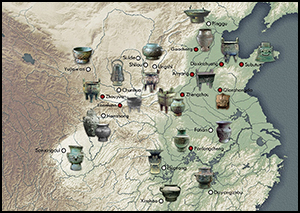Crossref Citations
This article has been cited by the following publications. This list is generated based on data provided by
Crossref.
Jin, Zhengyao
Liu, Ruiliang
Rawson, Jessica
and
Pollard, A. Mark
2017.
Revisiting lead isotope data in Shang and Western Zhou bronzes.
Antiquity,
Vol. 91,
Issue. 360,
p.
1574.
Pollard, A.M.
Bray, P.
Hommel, P.
Hsu, Y.-K.
Liu, R.
and
Rawson, J.
2017.
Bronze Age metal circulation in China – ERRATUM.
Antiquity,
Vol. 91,
Issue. 358,
p.
1130.
2018.
ANNUAL BIBLIOGRAPHY.
Early China,
Vol. 41,
Issue. ,
p.
477.
Liu, Ruiliang
Pollard, A. Mark
Rawson, Jessica
Tang, Xiaojia
Bray, Peter
and
Zhang, Changping
2019.
Panlongcheng, Zhengzhou and the Movement of Metal in Early Bronze Age China.
Journal of World Prehistory,
Vol. 32,
Issue. 4,
p.
393.
Pollard, A. M.
Liu, R.
Rawson, J.
and
Tang, X.
2019.
From Alloy Composition to Alloying Practice: Chinese Bronzes.
Archaeometry,
Vol. 61,
Issue. 1,
p.
70.
Hsu, Yiu-Kang
Sabatini, Benjamin J.
and
Xia, Qun-Ke
2019.
A geochemical characterization of lead ores in China: An isotope database for provenancing archaeological materials.
PLOS ONE,
Vol. 14,
Issue. 4,
p.
e0215973.
Rawson, Jessica
2019.
Ordering the material world of the Western Zhou.
Archaeological Research in Asia,
Vol. 19,
Issue. ,
p.
100096.
Li, Chenyuan
Li, Yanxiang
Wang, Lixin
Chen, Kunlong
and
Liu, Siran
2019.
Primary research on the bronze technology of Lower Xiajiadian Culture in northeastern China.
Heritage Science,
Vol. 7,
Issue. 1,
Radivojević, Miljana
Roberts, Benjamin W.
Pernicka, Ernst
Stos-Gale, Zofia
Martinón-Torres, Marcos
Rehren, Thilo
Bray, Peter
Brandherm, Dirk
Ling, Johan
Mei, Jianjun
Vandkilde, Helle
Kristiansen, Kristian
Shennan, Stephen J.
and
Broodbank, Cyprian
2019.
The Provenance, Use, and Circulation of Metals in the European Bronze Age: The State of Debate.
Journal of Archaeological Research,
Vol. 27,
Issue. 2,
p.
131.
Jaffe, Yitzchak
2020.
Recent research on the Western Zhou period: Introduction to the 2019 essays.
Archaeological Research in Asia,
Vol. 23,
Issue. ,
p.
100160.
LIU, Cheng
LIU, Ruiliang
ZHOU, Pengcheng
LU, Chun
YANG, Zengxin
POLLARD, A. Mark
HOMMEL, Peter
MA, Jian
CUI, Jianfeng
BRAY, Peter
TONG, Jianyi
and
RAWSON, Jessica
2020.
Metallurgy at the Crossroads: New Analyses of Copper‐based Objects at Tianshanbeilu, Eastern Xinjiang, China.
Acta Geologica Sinica - English Edition,
Vol. 94,
Issue. 3,
p.
594.
LIU, Ruiliang
POLLARD, A. Mark
LIU, Cheng
and
RAWSON, Jessica
2020.
Every Cloud has a Silver Lining: Using Silver Concentration to Identify the Number of Sources of Lead used in Shang Dynasty Bronzes.
Acta Geologica Sinica - English Edition,
Vol. 94,
Issue. 3,
p.
585.
Li, Haichao
Zuo, Zhiqiang
Cui, Jianfeng
Tian, Jianbo
Yang, Yingdong
Yi, Li
Zhou, Zhiqing
and
Fan, Jianan
2020.
Bronze production in the Ancient Chengdu Plains: A diachronic metallurgical perspective on a separate cultural region.
Journal of Cultural Heritage,
Vol. 43,
Issue. ,
p.
26.
Killick, D.J
Stephens, J.A
and
Fenn, T. R.
2020.
Geological constraints on the use of lead isotopes for provenance in archaeometallurgy.
Archaeometry,
Vol. 62,
Issue. S1,
p.
86.
Li, Haichao
Chen, Jianli
Cui, Jianfeng
Wu, Xiaohong
Yang, Yingliang
Huang, Fengchun
and
Xu, Tianjin
2020.
Production and circulation of bronzes among the regional states in the Western Zhou Dynasty.
Journal of Archaeological Science,
Vol. 121,
Issue. ,
p.
105191.
Li, Haichao
Zhou, Zhiqing
Liu, Yang
Wang, Yi
Wang, Zhankui
Wang, Lin
Tian, Jianbo
and
Cui, Jianfeng
2020.
Fighting and burial: the production of bronze weapons in the Shu state based on a case study of Xinghelu cemetery, Chengdu, China.
Heritage Science,
Vol. 8,
Issue. 1,
Perucchetti, L.
Montero-Ruiz, I.
and
Bray, P.
2020.
Mapping archaeometallurgical data of the Iberian Copper Age: Different ways to look at a big picture.
Journal of Archaeological Science,
Vol. 119,
Issue. ,
p.
105165.
Li, Haichao
Zuo, Zhiqiang
Cui, Jianfeng
Tian, Jianbo
Yang, Yingdong
Yi, Li
Zhou, Zhiqing
and
Fan, Jianan
2020.
Copper alloy production in the Warring States period (475-221 BCE) of the Shu state: a metallurgical study on copper alloy objects of the Baishoulu cemetery in Chengdu, China.
Heritage Science,
Vol. 8,
Issue. 1,
Li, H.
Gong, Y.
Cui, J.
Cai, Y.
Cai, Q.
Jiang, Z.
Zhou, Z.
and
Fan, J.
2021.
Imports or imitations?: Scientific and typological analysis of the bronze artefacts at the Moutuo Archaeological Site, Sichuan, China*.
Archaeometry,
Vol. 63,
Issue. 5,
p.
975.
Dong, Guanghui
Du, Linyao
and
Wei, Wenyu
2021.
The impact of early trans-Eurasian exchange on animal utilization in northern China during 5000–2500 BP.
The Holocene,
Vol. 31,
Issue. 2,
p.
294.



